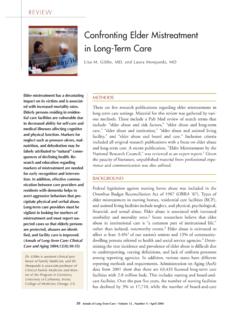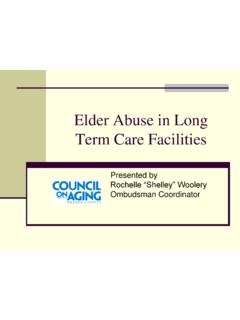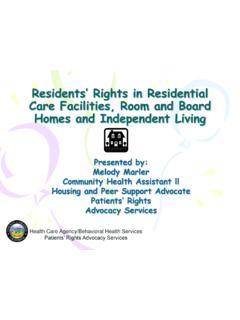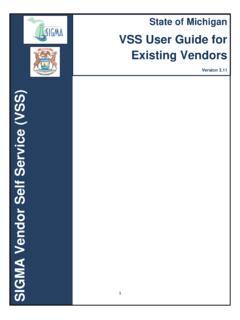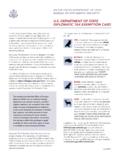Transcription of fact Abuse of Residents of Long Term Care Facilities sheet
1 Fact sheetAbuse of Residents of long Term care FacilitiesElder and vulnerable/dependent adult Abuse affects millions of people in the It occurs regularly in the community and in long term care settings such as nursing homes and board and care homes/assisted living Facilities (we use the term board and care herein). It has been reported that a vast reservoir of undetected and unreported elder mistreatment in nursing homes may exist (Bonnie & Wallace, 2002). Research indicates that more than 40% of people over the age of 65 will enter a nursing home before they die. (Murtaugh, Kember, Spillman, & Carlson, 1997). FACTS YOU NEED TO KNOWHow Many long Term care Facilities Are in the Many People Live in long Term care Facilities ?16,639 Nursing Homes with 1,736,645 bedsAccording to the National Center for Assisted Living (20 08), more than 900,000 people nationwide live in assisted living settings.
2 52,681 Board & care Homes with 1,212,015 bedsWho Lives in long Term care Facilities ?How Prevalent Is Elder and Vulnerable/Dependent Adult Abuse ? Nearly 1 in 3 nursing homes were cited for violations of federal standards that had potential to cause harm or that had caused actual harm to a resident during the two years 1999-2001. Nearly 1 out of 10 homes had violations that caused Residents harm, serious injury, or placed them in jeopardy of death. (2001 House of Representatives Report) In a study of 2,000 interviews of nursing home Residents , 44% said they had been abused and 95% said they had been neglected or seen another resident neglected. (Broyles, 2000) Over 50% of nursing home staff admitted to mistreating ( physical violence, mental Abuse , neglect) older patients within the prior year in one study. Two thirds of those incidents involved neglect. (Ben Natan, 2010) One survey of certified nursing assistants (CNA) found that 17% of CNAs had pushed, grabbed, or shoved a nursing home resident .
3 51% reported they had yelled at a resident and 23% had insulted or sworn at a resident . (Pillemer & Hudson, 1993) 7% of all complaints regarding institutional Facilities reported to long term care Ombudsmen were complaints of Abuse , neglect, or exploitation. (NORS Data 2010) million Americans resided in nursing homes during 20082 out of 3 are femaleFebruary 2012(NORS, 2010)(NORS, 2010)(CMMS , 20 09)1 of 7 are under 65 years old1 in 200 are under 30 years old6 of 7 are 65 years old or olderWhat Types of Abuse Are Occurring?Types of Abuse Complaints In US Nursing Homes (2010 NORS Data)Types of Abuse Complaints in US Board & care Facilities (2010 NORS Data) Physical Abuse Sexual Abuse Psychological Abuse Financial exploitation Gross neglect resident to resident abuseAbuse Rate by care SettingProtections of long Term care Residents Need StrengtheningBen Natan, M.
4 , & Lowenstein, A. (2010). Study of factors that affect Abuse of older people in nursing homes. Nursing Management, 17(8), 20-24. See , K. (2000). The silenced voice speaks out: A study of Abuse and neglect of nursing home Residents . Atlanta, GA: A report from the Atlanta long Term care Ombudsman Program and Atlanta Legal Aid Society to the National Citizens Coalition for Nursing Home Reform. See , C., Carrillo, H., Woleslagle-Blank, B, & O Brian, T. (2010). Nursing Facilities , staffing, Residents , and facility deficiencies, 2004 through 2009. Retrieved October 23, 2011 from , C. (2002). Elder Abuse in residential long -term care settings: What is known and what information is needed? In R. Bonnie & R Wallace (Eds.) Elder Mistreatment: Abuse , Neglect, and Exploitation in an Aging America (pp. 446-50 0) Washington DC: National Academies Press. Retrieved October 23, 2011 from , C.
5 & Kimbell, A. (2010). Detecting, addressing and preventing elder Abuse in residential care Facilities . Report to the National Institute of Justice, Dept of Justice. Retrieved October 28, 2011 from , C., Kemper, P., Spillman, B., & Carlson, B. (1997). The amount, distribution, and timing of lifetime nursing home use. Medical care , 35(3), 204 18. See Center for Assisted Living. (2009). Assisted Living resident Profile. Retrieved October 23, 2011, from , C., Conner, T., Prokhorov, A., & Fang, Y. (2009). The effect of care setting on elder Abuse : results from a Michigan survey. Journal of Elder Abuse & Neglect, 21(3), 239-252. See , K. & Hudson, B. (1993). A model Abuse prevention program for nursing assistants. Gerontologist, 33(1), 128-131. See , K. & Moore, D. (1989). Abuse of patients in nursing homes: findings from a survey of staff. Gerontologist, 29(3), 314-320.
6 See , L., Page, C., Conner, T., Prokhorov, A., Fang, Y. & Biroscak, B. (2010) Elder Abuse in long -term care : Types, patterns, and risk factors. Research on Aging, 32(3), 323 348. See Department of Health and Human Services, Administration on Aging. (2010). 2010 National ombudsman reporting system data tables. Retrieved October 23, 2011 from Department of Health and Human Services, Centers for Medicare and Medicaid Services. (2009) Nursing Home Data Compendium. Retrieved October 23, 2011 from Department of Health and Human Services (HHS), Office of Inspector General (OIG) (2006). Nursing Home Complaint Investigations. Retrieved October 23, 2011 from General Accounting Office, Report to Congressional Requesters (2002). Nursing Homes, More Can Be Done to Protect Residents from Abuse . Retrieved October 23, 2011 from House of Representatives, Committee on Government Reform, Special Investigations Division, Minority Staff.
7 (20 01) Abuse of Residents is a major problem in nursing homes, prepared for rep. Henry A. Waxman. Retrieved October 23, 2011 from more information: FOR NCEA BY:Our work shows that nursing home Residents need both stronger and more immediate protections. More should be done to protect nursing home Residents . (US GAO Report to Congress, 2002)Studies of the process States use to detect, investigate, resolve, and prevent elder mistreatment in nursing homes, assisted living Facilities , and board and care homes are deeply flawed. As a result, the estimates of elder Abuse and neglect are lower than the actual prevalence, and the processes must be strengthened to protect Residents . (US DHHS/OIG Report, 2006)The universal lack of resources, the enormous variation across jurisdictions, and the low priority given to elder Abuse and neglect make it difficult to see how significant progress can be made without some federal standards and financial support for investigating, detecting, resolving and preventing elder Abuse in residential care .
8 (Hawes, C. & Kimbell, A., 2010) This document was completed for the National Center on Elder Abuse and is supported in part by a grant (No. 90AB0002/01) from the Administration on Aging, Department of Health and Human Services (DHHS). Grantees carrying out projects under government sponsorship are encouraged to express freely their findings and conclusions. Therefore, points of view or opinions do not necessarily represent official Administration on Aging or DHHS policy.
